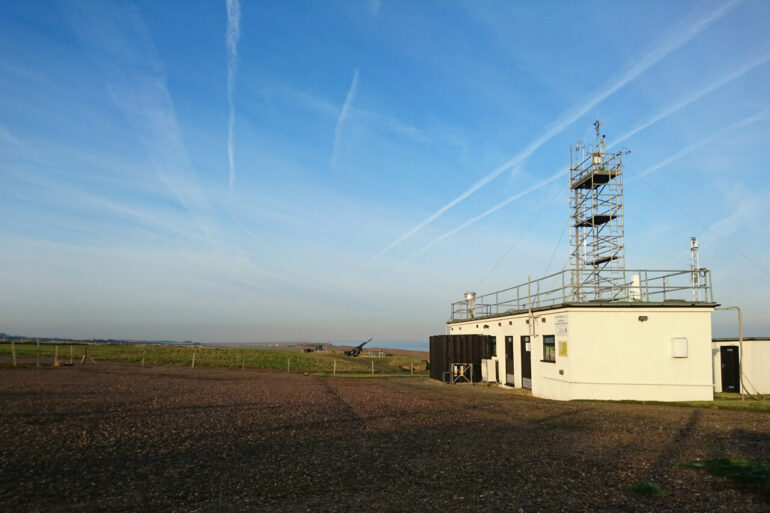A team of scientists led by the University of East Anglia (UEA) has made a major breakthrough in detecting changes in fossil fuel carbon dioxide emissions more quickly and frequently.
In a study published today they quantified regional fossil fuel CO2 emissions reductions during the COVID-19 lockdowns of 2020–2021, using atmospheric measurements of CO2 and oxygen (O2) from the Weybourne Atmospheric Observatory, on the north Norfolk coast in the U.K.
The estimate uses a new method for separating CO2 signals from land plants and fossil fuels in the atmosphere. Previously it has not been possible to quantify changes in regional-scale fossil fuel CO2 emissions with high accuracy and in near real-time.
Existing atmospheric-based methods have largely been unsuccessful at separating fossil fuel CO2 from large natural CO2 variability, so that estimates of changes, such as those occurring in response to the lockdowns, must rely on indirect data sources, which can take months or years to compile.
The atmospheric O2-based method, published in the journal Science Advances, is in good agreement with three lower frequency U.K. emissions estimates produced during the pandemic by the Department for Business, Energy and Industrial Strategy, the Global Carbon Budget and Carbon Monitor, which used different methods and combinations of data, for example those based on energy usage.
Crucially, as well as being completely independent of the other estimates, this approach can be calculated much more quickly.
The researchers are also able to detect changes in emissions with higher frequency, such as daily estimates, and can clearly see two periods of reductions associated with two U.K. lockdown periods, separated by a period of emissions recovery when COVID restrictions were eased, during the summer of 2020.
Researchers at UEA—home of the U.K.’s only high-precision atmospheric O2 measurement laboratory—worked with colleagues at Wageningen University in the Netherlands and the Max Planck Institute for Biogeochemistry, Germany.
The study’s lead author, Dr. Penelope Pickers, of UEA’s Center for Ocean and Atmospheric Sciences, said: “If humans are to reduce our CO2 emissions from fossil fuels and our impact on the climate, we first need to know how much emissions are changing.
“Our study is a major achievement in atmospheric science. Several others, based solely on CO2 data, have been unsuccessful, owing to large emissions from land plants, which obscure fossil fuel CO2 signals in the atmosphere.
“Using atmospheric O2 combined with CO2 to isolate fossil fuel CO2 in the atmosphere has enabled us to detect and quantify these important signals using a ‘top-down’ approach for the first time. Our findings indicate that a network of continuous measurement sites has strong potential for providing this evaluation of fossil fuel CO2 at regional levels.”
Currently, fossil fuel CO2 emissions are officially reported with a “bottom-up” approach, using accounting methods that combine emission factors with energy statistics to calculate emissions.
These are then compiled into national inventories of estimated greenhouse gas (GHG) emissions to the atmosphere from anthropogenic sources and activities, such as domestic buildings, vehicles, and industrial processes.
However, inventories can be inaccurate, especially in less developed countries, which makes it more difficult to meet climate targets.
It can also take years for the inventory assessments to be completed, and at the regional scale, or on a monthly or weekly basis, the uncertainties are much larger.
An alternative method of estimating GHG emissions is to use a “top-down” approach, based on atmospheric measurements and modeling.
The U.K. emissions inventory is already successfully informed and supported by independent top-down assessments for some key GHGs, such as methane and nitrous oxide.
But for CO2, the most important GHG for climate change, this has never before been feasible, because of the difficulties distinguishing between CO2 emissions from fossil fuels and land plant sources in the atmosphere.
Dr. Pickers said: “The time taken for inventories to be completed makes it hard to characterize changes in emissions that happen suddenly, such as the reductions associated with the COVID pandemic lockdowns.
“We need reliable fossil fuel CO2 emissions estimates quickly and at finer scales, so that we can monitor and inform climate change policies to prevent reaching 2°C of global warming.
“Our O2-based approach is cost-effective and provides high frequency information, with the potential to provide fossil fuel CO2 estimates quickly and at finer spatial scales, such as for counties, states or cities.”
The team used 10 years of high-precision, hourly measurements of atmospheric O2 and CO2 from Weybourne Atmospheric Observatory, which are supported by the U.K.’s National Center for Atmospheric Science. Having long-term measurements of these climatically important gases was crucial to the success of the study.
To detect a COVID signal, they had to first remove the effects of atmospheric transport on their O2 and CO2 datasets, using a machine learning model.
They trained the machine learning model on pre-pandemic data, to estimate the fossil fuel CO2 they would have expected to observe at Weybourne if the pandemic had never occurred.
They then compared this estimate to the fossil fuel CO2 that was actually observed during 2020-2021, which revealed the relative reduction in CO2 emissions.
“Novel quantification of regional fossil fuel CO2 reductions during COVID-19 lockdowns using atmospheric oxygen measurements,” by Penelope A. Pickers et al., is published in Science Advances on Friday, April 22, 2022.
More information:
Penelope A. Pickers, Novel quantification of regional fossil fuel CO2 reductions during COVID-19 lockdowns using atmospheric oxygen measurements, Science Advances (2022). DOI: 10.1126/sciadv.abl9250. www.science.org/doi/10.1126/sciadv.abl9250
Provided by
University of East Anglia
Citation:
Breakthrough in estimating fossil fuel carbon dioxide emissions (2022, April 22)



